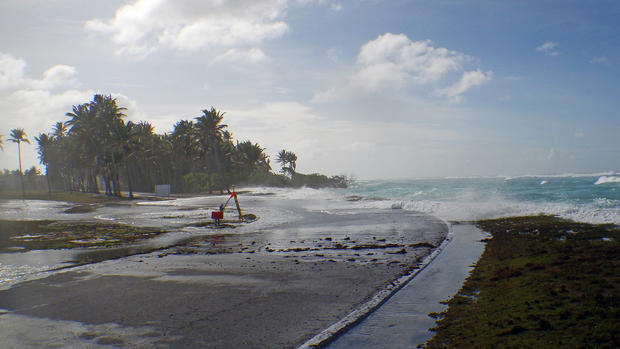Climate change could displace half a million people from islands
Residents of the Marshall Islands in the North Pacific know they have it bad. Flooding is on the rise and many face the real possibility that their island homes will disappear by the end of the century.
Now, a new study projects things could even be worse than previously thought for low-lying island atolls around the world, which are home to half a million people and also host several key U.S. military installations.
Studying the Northwestern Hawaiian Islands, scientists from the U.S. Geological Survey and their colleagues at the Deltares Institute in the Netherlands and the Hawaii Cooperative Studies Unit at University of Hawaii concluded that combined effects of storm-induced, wave-driven flooding and sea level rise on coral islands called atolls may be more severe and happen sooner than previously estimated.
"Many atoll islands will be flooded annually, contaminating the limited freshwater resources with saltwater, and likely forcing inhabitants to abandon their islands in decades, not centuries, as previously thought," USGS geologist and lead author of the study Curt Storlazzi, told CBS News.
Part of the reason, he and his time wrote in a study in Scientific Reports, is that most studies only factored in rising seas when concluding atolls like Tuvalu, the Maldives, and parts of the Gilbert Islands would be inundated anywhere between the years 2080 and 2150 due to climate change.
Rising sea levels are clearly a factor - oceans are projected to rise as much as 21 feet (6.4 meters) in the next century. NASA scientists have found that the ocean's mass is increasing due to warming temperatures, leading sea levels to rise about 1.9 millimeters (0.07 inches) per year.
But the scientists said atolls - ring-shaped reefs that often include islands large enough for human habitation - are also vulnerable to waves that would become worse as the seas rise.
Currently, the reefs often serve as a buffer for communities living on the atolls, breaking up and weakening the waves as the make landfall. But as the seas rise, the wave heights are projected to be greater and thus they will run further up the beachfront, Storlazzi said.
Climate change could also weaken these reefs, since warming water causes coral bleaching and makes them more susceptible to disease. Ocean acidification, another result of greenhouse gases going into the oceans, is also expected to cause some reefs dissolve because they no longer can absorb the calcium carbonate that they need.
"A very healthy coral reef will have a lot of friction and attenuate a lot of wave energy," Storlazzi said. "If coral reefs decay or die due to natural or human induced stressors, they are thus less effective as a buffer to the waves."
Storlazzi said scientists couldn't put an exact date on when these atolls will be inundated, partly because there remains a range of projections for sea level rises and atolls have a mix of elevations.
But he warned that the impact will likely drive residents off these atolls long before the land itself goes underwater.
"If you drive storm waves across islands, there is going to be a lot of impacts to the infrastructure, critical habitats as well as threatened and endangers species," he said.
"The biggest issue is water availability. These islands have a limited freshwater lens," he said, using a term which refers to the layer of freshwater over the seawater that occurs when it rains. "If all of sudden you overwash the islands so that it's flooded with seawater, you contaminate that freshwater lens ... If you don't have freshwater, you don't have human habitation."
